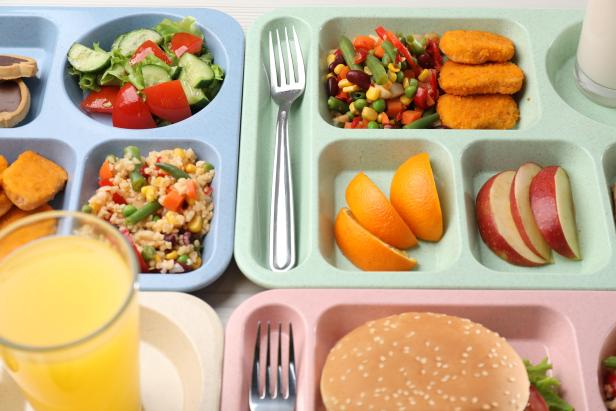 photo credit: Shutterstock
photo credit: ShutterstockAs a director of food and nutrition, it's mundane to spend each day feeling stuck in the same endless cycle.
"We really wanted to break that kind of mold," said Erin Primer, the director of food and nutrition services for the San Luis Coastal Unified School District, starting with flavor.
"What kind of flavors could we introduce to our students? And a lot of times, looking at different cultures and different parts of the world, you can really lead with delicious flavors."
They've since started serving sweet potato, black bean chimichurri bowls and plates of coconut rice with a red lentil dal, which the students have loved.
San Luis Coastal Unified is among more than 300 districts across California that receive funds from Local Food for Schools -- a federally funded program run by the U.S. Department of Agriculture, which allocates money to states to help schools develop farm-to-school pipelines.
The program is widely seen as a win-win for schools that receive fresh, local produce and opportunities to teach students about food systems; for local economies and farmers who are granted a reliable income source; and for the environment, as locally sourced foods don't need to be shipped long distances.
Roughly half of the state's students benefit, to some extent, from farm-to-school programs, and California schools have received about $23 million in Local Food for Schools (LFS) grants.
But the current federal administration gutted the program in March, straining farmers and forcing districts across the state -- the vast majority of whose nutrition services run on their own, self-sufficient budget -- to make harder decisions in a time when the cost of food is already on the rise, according to Suzanne Morales, the president of the California School Nutrition Association.
"It just changes your thought process because you don't have the additional funding to say, 'Yes, we can make that work because of the fact that we have the ability to have additional funding,'" Morales said. "Your purchasing looks a little bit different and may not support your local economy as much."
Any additional losses in funds for school meals, Morales said, could prove detrimental and would come at a time when the state has moved to phase out ultra-processed foods under a new law signed by Gov. Gavin Newsom.
"The last thing we want to do is cut for children's nutrition because children who are hungry or malnourished can't learn," Morales said.
Magenta dragon fruit and local produce go 'viral'
Every Wednesday, workers at the Tahoe Food Hub load up more than 2,000 pounds of produce -- ranging from summer watermelons to winter squashes -- for delivery to the Tahoe Truckee Unified School District, which has been involved in farm-to-school programs for more than a decade.
And directors of school nutrition across the state have been shocked to see how students' tastes develop when they're introduced to new fruits and vegetables.
In Tahoe Truckee Unified, turnip salads have proven a surprise favorite. And in the Capistrano Unified School District, magenta dragon fruit has gone "viral" among students, according to Kristin Hilleman, a director of food and nutrition services.
Since the pandemic, Capistrano Unified's program has seen significant growth -- from roughly 30,000 pounds of local produce a year to 80,000 pounds.
And as a result of farm-to-school programs, Primer said San Luis Coastal Unified is serving more students and has been able to expand its team from about 20 employees to about 50.
"It's always a surprise to me, kind of what types of food kids really enjoy when they're exposed to it," said Maddie Rohner, the general manager of the Tahoe Food Hub.
"It's unfortunate that some of those kids aren't necessarily going to get the same opportunities to try those types of unique offerings with these types of cuts."
Learning with and about food
Building relationships with local farmers does more than provide students with more nutritious and tasty meals; it also presents opportunities to learn more about food systems and how produce arrives on their plates.
In Tahoe Truckee Unified, students in fourth and fifth grade take field trips to local farms that are part of the Tahoe Food Hub and spend the day learning about "what happens on a farm and why it's so important, the whole ecosystem of a farm, and then that comes directly to us," said Kat Soltanmorad, the director of food and nutrition at Tahoe Truckee Unified.
Elsewhere, farmers visit campuses and teach students about various crops. And in the Lodi Unified School District, students actively participate in the farm-to-school pipeline through hydroponic systems -- a vertical growing system that doesn't require soil -- in classrooms, according to Betty Crocker, a district director of nutrition services.
What is grown in the classroom, she said, ultimately makes its way onto students' plates.
"My dream is to one day say that all of our lettuce is grown by our kiddos," Crocker said.
Morales of the California School Nutrition Association added that in addition to learning about where our food comes from, produce can also be a tool in regular classroom subjects.
"Teachers are able to add that to their curriculum," Morales said, "whether it be a geography lesson: Where's the farm in relation to us? It could be a math lesson: How long would it take me to get there? How many miles is it?"
Losing money
The amount of money a school receives -- and now stands to lose from the Local Food for Schools program -- depends on its size, ranging from Los Angeles Unified, the state's largest district, which has received about $2.9 million in LFS funds, to Tahoe Truckee, a district of just over 4,000 students, which received a $31,000 allocation.
"While we remain deeply committed to serving students the highest-quality meals possible, these reductions directly affect what we're able to put on the plate," the Los Angeles Unified School District, which participates in farm-to-school programs at each of its campuses, said in a statement to EdSource.
Local farmers also stand to lose. Rohner of the Tahoe Food Hub said that Tahoe Truckee Unified is their biggest wholesale customer and fills a critical gap in customers during the fall and winter months.
Claire Tauber, the Farm to School manager at Community Alliance with Family Farmers, also said the cuts make it harder to plan for upcoming seasons.
"If you know when [funding] is going to end, you can prepare for it and look for new markets," she said. "But when funding is cut abruptly, it creates a little bit of a vacuum and can destabilize what's already a super inconsistent market for farmers."
Other grants support farm-to-school programs, but Soltanmorad emphasized that schools shouldn't always have to rely on temporary grants to fund larger nutrition initiatives.
"Not only are families feeling it, we feel it in terms of inflation, food supply chain issues," Soltanmorad said. "We don't want to go back. We don't want to go to processed foods. We don't want to eliminate labor. We don't want to eliminate our chefs in schools that create these amazing dishes that are healthy and delicious for students."

 Live Radio
Live Radio




